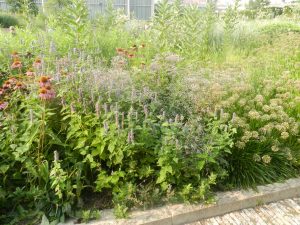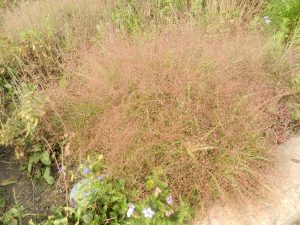
Liatris, Eryngium, and Echinacea deadheads, repetition of mounding Amsonia in background
In early August, I visited the Lurie Garden at Millenium Park in Chicago with the Garden Writers Association. The gardens are a masterpiece of landscape design designed by Piet Oudolf to blend perennials and ornamental grasses, with just as much emphasis on their appearance after bloom as on varying types of bloom. This means having an intimate acquaintance with deadheads – obviously not the musical Deadheads.
I had seen these gardens once before in the month of June when the garden was still fairly new. What I remember most was the repetition of masses of Salvia ‘Caradonna’ as they wove throughout the beds, creating a purple haze.

Echinacea, Agastache, Allium, Limonium

Liatris, Eryngium, and Echinacea deadheads, Limonium latifolium
This time, the Salvia was barely noticeable, being between flushes of blooms. Instead, the most prominent perennial was Echinacea and it was a companion of several other perennials. Most of the blooms were muted hues – the soft pinks of Echinacea, Phlox paniculata, and the just-starting-to-bloom Anemone hupehensis ‘Praecox’, the silver of Erygium yuccifolium (Rattlesnake Master), and the soft lavenders of Agastache ‘Blue Fortune’, Ruellia humilis (Wild Petunia), and Limonium latifolium (Sea Lavender).

Echinacea purpurea, Euphorbia corollata
Although white is usually regarded as a strong color, in this glaring, full sun site, it seemed more subdued. The tiny flowers of Calamintha nepeta ssp. Nepeta and of Euphorbia corollata (Flowering Spurge), a rarely seen perennial, were excellent foils for their neighbors. The Calamintha was in the foreground due its dimunitive size but the Euphorbia was in the foreground as well as further back because it easily reaches four feet in height. Both perennials have masses of tiny flowers that create a strong contrast with the multi-petaled Echinacea.

Silphium lacinatum, Echinacea white
The exception to these muted colors was the yellow of Silphium lacinatum (Compass Plant). It was quite noticeable, not just because of the color but also because of its height and its large, dentate, fingered foliage.

Eragrostis spectabilis
Several different grasses meander throughout the gardens adding a linear and fine texture, among them Calamagrostis acutiflora ‘Karl Foerster’ (Feather Reed Grass), Deschampsia caespitosa ‘Goldstaub’ (Tufted Hair Grass), Eragrostis spectabilis (Purple Love Grass), Molinia litoralis ‘Transparent’ (Moor Grass), Panicum virgatum ‘Shenandoah’ (Red Switch Grass), Sesleria autumnalis (Autumn Moor Grass), and Sporobolus heterolepis (Prairie Dropseed).

Agastache with Monarch butterflies
The size of the gardens necessitates the use of large masses of each selected plant in order to strongly impact the vision of the visitor. The most obvious visitors are human but bee and butterfly visitors were quite evident in the gardens. It was a delight to see so many Monarch butterflies, especially on the Agastache ‘Blue Fortune’.
If you have occasion to visit Chicago, make these gardens a must-see.


0 Comments